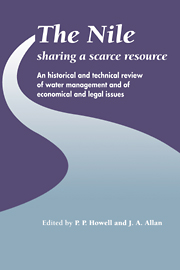 The Nile: Sharing a Scarce Resource
The Nile: Sharing a Scarce Resource Book contents
- Frontmatter
- Contents
- Preface
- List of Contributors
- Orthography
- Units and Conversion Factors
- Introduction
- I Environmental history of the Nile and its management
- II Nile management and factors affecting future management
- III Future utilisation of Nile waters
- IV Economic, international and legal issues
- 14 Evolving water demands and national development options
- 15 The Nile Basin: water management strategies
- 16 History of the Nile Basin and Lake Victoria basins through treaties
- 17 Principles and precedents in international law governing the sharing of Nile waters
- 18 Law and the River Nile: emerging international rules and the Sharia'h
- 19 Developing policies for harmonised Nile Waters development and management
- Index
14 - Evolving water demands and national development options
Published online by Cambridge University Press: 05 February 2012
- Frontmatter
- Contents
- Preface
- List of Contributors
- Orthography
- Units and Conversion Factors
- Introduction
- I Environmental history of the Nile and its management
- II Nile management and factors affecting future management
- III Future utilisation of Nile waters
- IV Economic, international and legal issues
- 14 Evolving water demands and national development options
- 15 The Nile Basin: water management strategies
- 16 History of the Nile Basin and Lake Victoria basins through treaties
- 17 Principles and precedents in international law governing the sharing of Nile waters
- 18 Law and the River Nile: emerging international rules and the Sharia'h
- 19 Developing policies for harmonised Nile Waters development and management
- Index
Summary
Introduction
The nine states of the Nile Basin though connected by the river are not moved to relate intensely to each other. The river itself is of major current strategic economic importance to only one country, Egypt, although it will become increasingly significant to one other, the Sudan, in the near future as the utilization of Nile water reaches the maximum level sustainable by existing river flows as currently managed. The other measure of interaction and interdependence, trade, indicates that the countries of the Nile Basin have little reason to communicate. The dominant trading partners of all nine countries, for exports as well as imports, are from the industrialized economies of Europe, North America and the Far East. Nor are there any uniting elements in the field of international relations; there are no strategic groupings based on shared anxiety or mutual interest with respect to factors particular to the Nile and its catchment. The major international forum at the continental level, the Organization of African Unity (OAU), embraces all African countries and not just those with parts of their territories in the Nile Basin. It has a potential mediating role but is unlikely to be the body which steers basin-wide relations. The reason for this is the imperative that future development of Nile water will require substantial investment at levels which will be extremely difficult to mobilize from indigenous Nile Basin resources.
- Type
- Chapter
- Information
- The Nile: Sharing a Scarce ResourceA Historical and Technical Review of Water Management and of Economical and Legal Issues, pp. 301 - 312Publisher: Cambridge University PressPrint publication year: 1994
- 1
- Cited by
